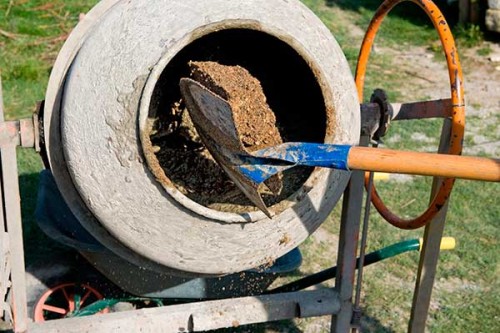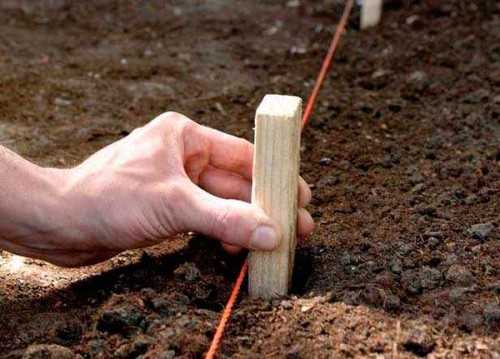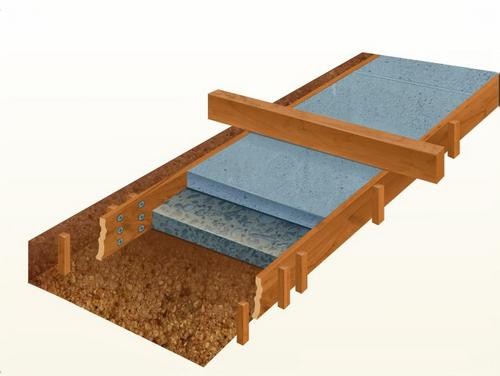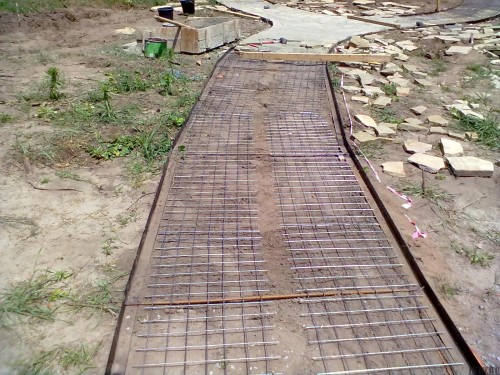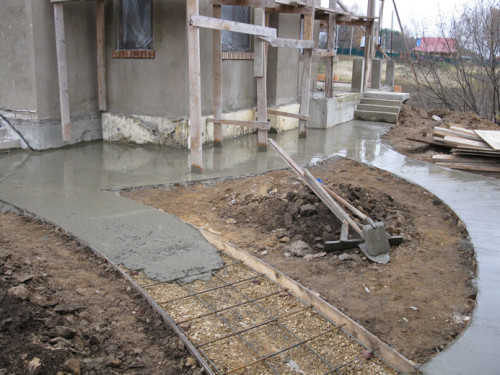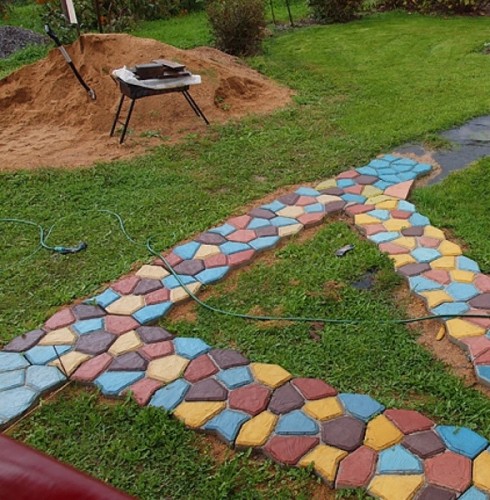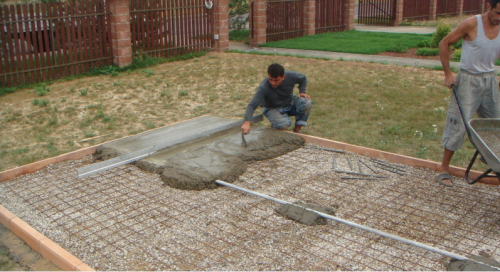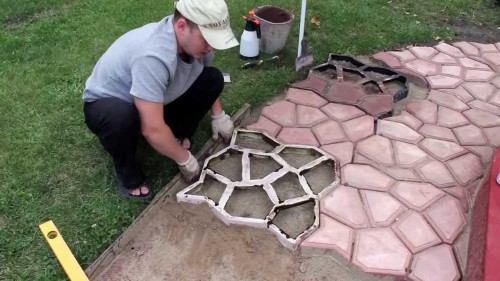
We produce pouring tracks yourself Plot.

Tracks in the garden should be such that in any weather you can take a walk. The pouring of the tracks concrete will help. This material is resistant to groundwater, withstands significant loads, not afraid of low temperatures and bright sun. But in order for it to serve for many years, the fill of garden tracks should be performed with the observance of technology.
Content
Materials and tools for work
Pouring tracks with their own hands requires materials, tools and devices from the following list:
- boards or sheets of plywood (thickness of at least 10 mm) - for mounting formwork);
- reinforcing mesh of rods with a diameter of 4-5 mm;
- capacity for the preparation of the solution;
- kelma and a wide spatula;
- hacksaw;
- hammer;
- nails (selflessness);
- tree pegs and twine;
- construction level;
- shovel, bucket and rake.
In sufficient quantity (depends on the amount of work) requires cement M400, gravel, sand river and water.
Tip: knead the solution will be easier with the help of concrete mixer. It is enough to purchase or rent an aggregate with a tank volume - 100 liters.
Solution for filling tracks
The solid coating for the paths of pedestrian and races for cars requires the preparation of a solution in various proportions.
- For non-coming part: cement, sand and gravel mixed in proportions 1: 2: 4, respectively.
- For vehicles (in entry into the garages and parking lot): the proportion of mixing the same components - 1: 1: 2. Such a composition of the material is able to withstand the weight of a passenger car.
Important: Gravel should not contain extraneous impurities. This has a significant impact on the quality of the solution and, accordingly, the strength of the garden path. To clean gravel, it is washed with water before use.
Singing the solution is performed in a certain sequence of actions. Adhering to the following recommendations, it is possible to greatly facilitate the work and get a high-quality mixture.
- In the plastic or metal container, sand and gravel are poured in the desired proportion and stirred.
- Cement is added to the mixture, after which the kneading continues.
- In small portions, water is added in the process of stirring. It is important not to exceed the dosage.
It is necessary to check the consistency of the solution during the preparation process. It should be creamy, swallow from a trowel with some slowdown.
Pouring concrete tracks: phased technology description
The whole process can be divided into several stages.
Preparatory work
The sequence of actions at this stage is as follows.
- Selection of direction and shape of the tracks. They can be straight and winding depending on the overall style of landscape design and personal preferences.
- Plots of the preservation area where the tracks will be laid, free from trees and shrubs.
- There is a marking of future tracks. In their edges, pegs are rush to the ground in sufficient quantities, so that you can accurately designate the boundaries on both sides. Rope stretches between waists.
- Between the borders of the track, the turf is removed and the trench of the depth of about a quarter of the meter. The layer of waterproofing is stacked, which uses a rubryoid or polyethylene film with a thickness of at least 0.5 μm. The material should go on the walls of the trench.
- On top of the waterproofing, sand is poured, moistened and compacted with a rubbing. On top of sand - crushed stone, after which the subflink from the sand is satisfied again. All layers are trambed.
Installation of formwork
The formwork is made of boards or sheets of plywood and is installed according to the following rules.
- The upper edge of all elements should be on one, horizontal level.
- Strength is provided at the expense of retaining pegs: they are in sufficient quantities on both sides are driven into the ground from the outside. In the upper part of the formwork is bonded by horizontal cross.
- In order to be easier to dismantle the formwork, the boards are treated with machine oil or other lubricant.
To improve the formwork of the curvilinear form, you can use moisture-resistant faeer.
Important: The formwork should rise above the ground level of at least 50 mm. In order not to be forced rain and melting water, it is necessary to provide a slope of 3-5 degrees.
At the reinforcement stage
So that the garden tracks served for a long time, a laying of reinforcement in a concrete solution is required. This will prevent cracking under the influence of the load and as a result of the sorting of soil.
For reinforcement, a metal grid of a rod with a diameter of 5 mm with a cell is 50 × 50 mm. There are also waste of the chain mesh relevant parameters. Put the reinforcement in the middle layer so that the edges are coated with a solution of 20-30 mm.
Pouring concrete
All actions are performed in the following order.
- The prepared concrete mixture on a plot equal to the length of the element of the reinforcement grid is evenly poured up to about the middle of the formwork.
- We put the reinforcement grid.
- Pour the concrete over the grid to the edges and align the surface with a wide spatula. During the fill, the formwork is tested, so that concrete evenly filled the entire volume, without forming air emptiness.
- We hide the path with a plastic film and leave to dry by 6-7 days.
Garden track decoration techniques
So that the garden track look original, use the following methods for decorating a concrete surface.
- Over the raw surfaces spend the tip of the spatula: the curves of the lines create an outline, imitating wild stone (blocking).
- Another non-frozen surface of a concrete solution pour out marble crumbs and the slight movements of the spatula rubbing it. As a result, the track will be durable and not slippery.
- Apply a special mixture based on wax. Such a coating, in addition to decorative functions, serves as protection for concrete from wind and precipitation.
- In the process of kneading concrete make pigment additives. You can use dyes of contrasting colors, phasy-pouring formwork. Thus, it is possible to "zonate" the household territory.
- Apply facing materials: ceramic tiles, mosaic. Along the edges lay out sea pebbles.
- Garden lanterns are installed along the tracks, perennial shrubs are planted.
With the help of pigments of various colors, garden track can be made original.
Garden track device using paving
Distinguish the following types of pavers:
- granite: It is a natural stone of the correct form, it is distinguished by increased strength and wear resistance;
- clinker: from the burned clay of a special variety;
- vibropressive: manufactured from cement mortar using dyes;
- rubber: used for children's and sports grounds.
Vibropressed blocking
The greatest distribution received vibropressed paving slaves, thanks to good performance and relatively low prices.
Stacking technology: phased description.
- Plot is prepared: markup is performed, the turf is removed, the soil is applied to pneumothbrush.
- The gravel layer is poured (about 10 cm), which should also be sealing.
- Carts are installed in the grooves and are strengthened by cement-sandy solution.
- On top of the gravel, the geotextile is stacked and a gartster is poured, which is a mixture of sand with cement in proportion of 5: 1, respectively. Hard layer thickness - 6-8 cm. The mixture is leveled with a rule or a wide spatula in terms of level.
- The elements of the paving slabs are stacked on the garts and are adjusted by the level of rubber xy. You should leave a gap of 4-5 mm. After laying, the paving can be sealing vibropres.
- The surface of the track is richly irrigated with water.
- The seams between the tiles are filled with a dry cement-sandy mixture, which is also moisturized. After hardened (after 6-7 days), the cement-sand mixture can be used for its intended purpose.
After laying, the pavement is watered with water from the hose
Important: To improve the pedestrian zone, you can use a paving 40-50 mm thick, and for vehicles - at least 90 mm. The base for laying a paving slave in the area (parking) of heavy vehicles should be concrete (a thickness of at least 100 mm).
Preparation of concrete base for stacking paving
To your attention a video with a specialist story about some nuances of work.
Use forms to fill tracks
The need for decoration will disappear, if you use special forms to fill garden tracks. Buy plastic forms with rigid ribs are recommended in such a quantity to minimize the loss of time waiting for a solidification of the solution.
The fill technology of the tracks does not require installation of formwork and involves compliance with the next sequence of actions.
- We carry out preparatory work as indicated above.
- We prepare a solution from the cement of the M300 - M500 grade and sand in the proportion of 1: 3. We add water and stir until the pasty consistency is obtained. The color of the solution can be changed by adding a pigment.
- In order for the solution to be homogeneous, add a plasticizer (liquid soap). Thus, it is possible to do without the use of vibrationovers.
- We put the shape on the track and fill it with a solution, periodically knocking on the edge of the form for filling the tracks. You can buy forms on the Internet or in a construction store.
- After 15-20 minutes, we carefully remove the form, clean the solution from traces and lay it on a new place. The process is repeated until the track is fully ready.
To your attention a video about how the form for filling a garden path is used.





